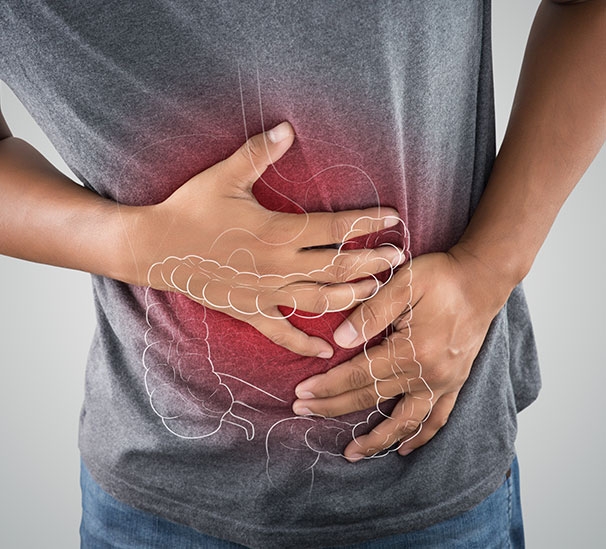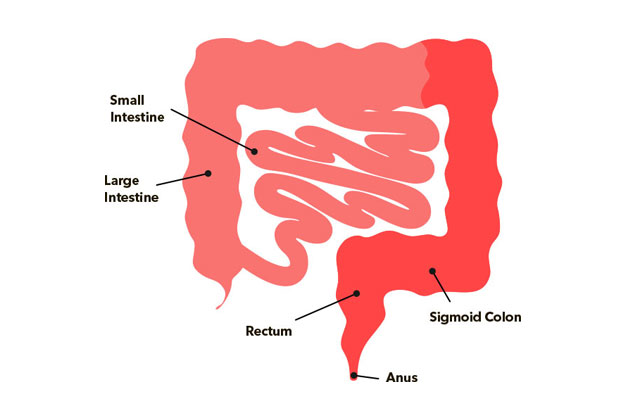Inflammatory bowel disease (or IBD) is a group of chronic idiopathic, relapsing and remitting disorders that cause inflammation of the gastrointestinal tract.1–3Although it was traditionally regarded as a disease of westernised nations, IBD is becoming a global disease at the turn of the 21st century.2 It impacts every aspect of the affected individual's life4 and accounts for substantial costs to the health care system and society.4
Over 3.5 million people affected in the Western world

The prevalence of IBD in the Western world is up to 0.5% of the general population2
- Ng SC, et al. Lancet. 2018;390(10114):2769–2778.
- Kaplan, GG. Nat Rev Gastroenterol Hepatol. 2015;12:720–727.

The types of IBD and risk factors
There are two main types of IBD: ulcerative colitis (UC) and Crohn’s disease (CD).5 Ulcerative colitis is a predominantly mucosal disease, its fundamental symptoms is rectal bleeding, and involves the rectum and can affect part of the colon or the entire colon in a continuous pattern.6 In contrast, Crohn’s disease can affect any part of the gastro-intestinal track (from mouth to rectum), although its location more common is the ileum.
Multifactorial Disease
Imbalance of Intestinal Microbiota Causitive & aggravating factors

- Khor B, et al. Nature. 2011;474(7351):307–317.
- Russell R. Postgrad Med J. 2001;77(904):82–88.
- Bjarnason I, et al. Pharmacol Ther. 1994;62(1–2):145–157.
- Mokhtarifar A, et al. Middle East J Dig Dis. 2013;5(2):93–97.
- Ni J, et al. Nat Rev Gastroenterol Hepatol. 2017;14(10):573–584.
- Ananthakrishnan AN, et al. Nat Rev Gastroenterol Hepatol. 2018;15(1):39–49
Although, ulcerative colitis and Crohn’s disease differ in location and depth of inflammation, they share similar symptoms.7 In general, the symptoms depend on the segment of the intestinal tract involved.8 Symptoms related to inflammatory damage in the gastrointestinal tract include diarrhoea (characterised by stools with mucus or blood, nocturnal diarrhoea or incontinence), constipation, pain or rectal bleeding with bowel movement, bowel movement urgency, tenesmus, abdominal cramps and pain, nausea and vomiting.8,9 If you have IBD you are at higher risk of also having iron deficiency and iron deficiency anaemia. Indeed, anaemia is the most common non-intestinal symptom of IBD10.
Ulcerative Colitis1,2
- Rectal pain, with or without diarrhoea
- Bloody diarrhoea
- Rectal bleeding
- Faecal incontinence
- Urgency / tenesmus
- Nocturnal defecation
- Abdominal cramps or pain
- Increased frequency of bowel movements


Crohn’s Disease3
- Abdominal pain often found in the lower right quadrant
- Chronic diarrhoea that can alternate with episodes of constipation
- Rectal bleeding or bloody diarrhoea
- Nausea / vomiting
- Ungaro R, et al. Lancet. 2017;389(10080):1756–1770.
- Magro F, et al. J Crohns Colitis. 2017;11(6):649–670.
- Torres J, et al. Lancet. 2017;389(10080):1741–1755.
Why are you at risk?
If you have IBD of any kind, you are at risk of iron deficiency. Learn more about the risk of IDA.
- WGO Global Guidelines. 2015
- Ng SC et al. Lancet. 2017;390:2769–2778
- Wilhelm SM and Bryan L. Clinical Pharmacist. 2017;Vol 9(3):online. DOI: 10.1211/CP.2017.20202316
- Burisch J et al. J Crohns Colitis. 2013;7(4):322–337
- Kaser A et al. Annu Rev Immunol. 2010;28:573–621
- Guan Q. J Immunol Res. 2019;2019:7247238
- Kim DH and Cheon JH. Immune Network. 2017;17(1):25–40
- WGO Global Guidelines. 2015
- Rowe WA. Inflammatory Bowel Disease: Practice Essentials, Background, Pathophysiology. Medscape. 2017
- Stein J, Hartmann F, Dignass AU. Diagnosis and management of iron deficiency anemia in patients with IBD. Nat Rev Gastroenterol Hepatol. 2010;7(11):599-610. doi:10.1038/nrgastro.2010.151.
如果您患有任何一种IBD,那么您存在缺铁风险。大约36%-76%的IBD患者出现缺铁性贫血。了解有关IDA风险的更多信息。
缺铁症状可能会影响您身体的许多部位。您可能会同时出现一个或多个这些症状。探索所有缺铁体征。
如果您已被诊断出患有IBD,那么您将可能与您的医生定期进行随访约诊。如果您一直感到疲乏,或者有任何其他缺铁体征,例如苍白、感觉头晕或者心跳加速,那么您可能想要就您的症状和缺铁咨询您的医生。思考医生可能需要的信息非常有用,以便找出引起您的症状的原因。您的医生可能会进行血液检查来检查您的铁状态,然后建议治疗以改善您的铁状态。
一旦您的医生检测了您的铁含量,他们就能决定最适合您的治疗。这将取决于您缺铁的程度,可以是建议如何从您的饮食中获得更多的铁和/或推荐您可使用的药物来改善您的铁水平。可通过以下链接获取更多关于不同的治疗选择和如何从您的饮食中获得最多的铁的信息。
如果您患有任何一种IBD,那么您存在缺铁风险。大约36%-76%的IBD患者出现缺铁性贫血。了解有关IDA风险的更多信息。
缺铁症状可能会影响您身体的许多部位。您可能会同时出现一个或多个这些症状。探索所有缺铁体征。
如果您已被诊断出患有IBD,那么您将可能与您的医生定期进行随访约诊。如果您一直感到疲乏,或者有任何其他缺铁体征,例如苍白、感觉头晕或者心跳加速,那么您可能想要就您的症状和缺铁咨询您的医生。思考医生可能需要的信息非常有用,以便找出引起您的症状的原因。您的医生可能会进行血液检查来检查您的铁状态,然后建议治疗以改善您的铁状态。
一旦您的医生检测了您的铁含量,他们就能决定最适合您的治疗。这将取决于您缺铁的程度,可以是建议如何从您的饮食中获得更多的铁和/或推荐您可使用的药物来改善您的铁水平。可通过以下链接获取更多关于不同的治疗选择和如何从您的饮食中获得最多的铁的信息。



